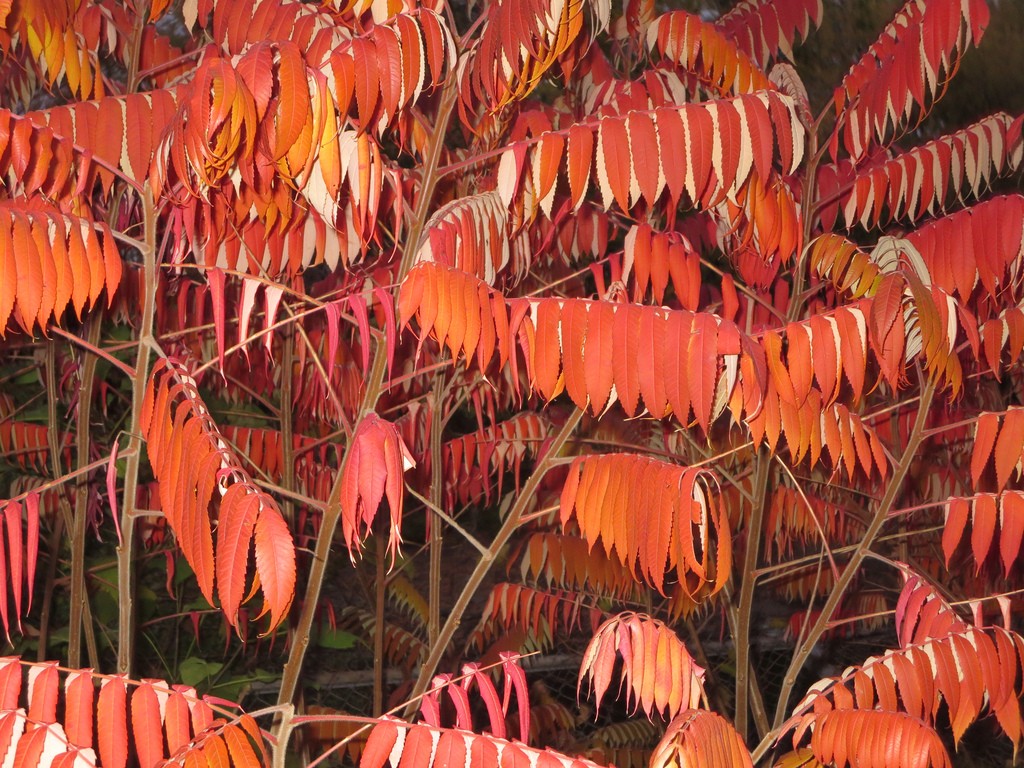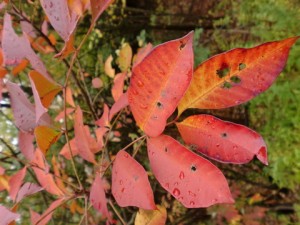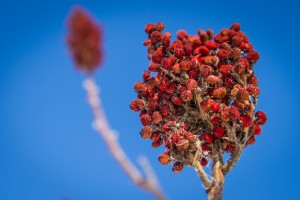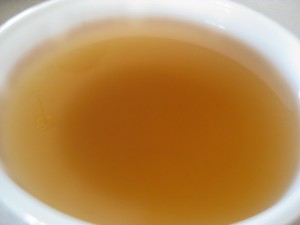Sumac: “Ade” for what ails you

Staghorn Sumac in fall color. Photo: Ann Fisher, Creative Commons, some rights reserved
One of the brightest—almost electrified—fall leaf colors hails from a humble source. Farmers may consider the ubiquitous sumac a weed and many people even think it’s dangerous. Its reputation as a nuisance stems, if you will, from its habit of creeping into fields and pastures by way of its root system, but our native staghorn sumac (Rhus typhinia) is by no means a hazard. And its vibrant red-orange leaves that seem to wave to us from highway and byway this time of year are almost unparalleled in their brilliance.
Just as Dorothy learned there were good witches and bad witches in Oz, I had to learn about good and bad sumac. When I was a kid, Dad showed me poison ivy and warned, sight unseen, against poison sumac. For some reason poison oak didn’t make the cut. Much the way “Marco” always went with “Polo,” “poison” was followed by either “ivy” or “sumac” in my mind. I was a young adult before I learned the difference. Staghorn sumac is not only safe to touch, it tastes great.

Poison sumac is uncommon. It is found in marshy areas and it’s berries mature from green to off-white. Photo: Eliza Barrett, Creative Commons, some rights reserved
Mind you, poison sumac is real. It’s just that few people ever see it. If you do, as I have, you’ll be ankle-deep, or deeper, in water. Poison sumac grows in swamps, and other than the fact it has compound leaves and is a shrub, it has many features that distinguish it from the sumac we see every day.
Poison sumac has loose bunches of berries that turn from green to off-white as they mature, and the clusters droop down. It has smooth twigs, and glossy leaves that turn yellow in the fall. “Good” sumac, on the other hand, bears red berries in tight, cone-shaped bunches, held up proudly like Lady Liberty’s torch. Staghorn sumac also has fuzzy twigs and matte-finish leaves which turn red in autumn.

Sumac-ade is made from the red berry clusters. Photo: Brett Whaley, Creative Commons, some rights reserved
The substance that makes apples tangy is malic acid, and sumac berries are loaded with this tasty water-soluble flavoring. To make “sumac-ade” all you need is a clean plastic bucket full of sumac berry bunches—don’t bother picking berries individually. Fill the bucket with cold water, agitate the berries for a few minutes and strain through a clean cloth. This leaves you with a very sour pink beverage akin to dilute lemon juice. Sweeten your sumac-ade to taste and serve with ice.
Because malic acid is water soluble, sumac berries lose some, but by no means all, of their flavor due to rain leaching it out. But even in the spring you’ll be surprised how tangy the berries can be. They are also a food source for American robins and other migratory songbirds that arrive early. I have no idea if they care about the flavor, though.

Sumac-ade is good cold or hot and is also known as Indian lemonade. Photo: Courtney “Coco” Mault, Creative Commons, some rights reserved
There are other species of good sumac in addition to staghorn, and they all have the same red berry clusters pointing upward. Some people actually plant sumac in the landscape both for the fall color and to attract birds. I know of at least two staghorn sumac cultivars and there are other species such as oak-leaf sumac, all of which you can order from specialty nurseries.
The next time sumac’s bright autumn flag catches your eye, consider stopping to collect some berries to make a refreshing batch of ade. And the sooner the better.
Paul Hetzler is a horticulture and natural resources educator with Cornell Cooperative Extension of St. Lawrence County.







